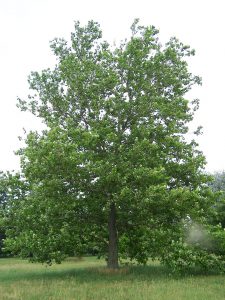“How old and diverse is our urban canopy?”
—Bruce Pierini
SCNA board member Dan Pskowski answers:
Sacramento’s urban forest was created over the past 164 years, a forest shaped by human settlement. This drove Sacramento’s transition from the City of the Plains to the City of Trees. C.K. McClatchy, The Sacramento Bee’s editor from 1883 to 1936, was the city’s most prominent tree booster by promoting trees through his publication.
During Sacramento’s early years, there wasn’t much species diversity. The English elm was the dominant species planted in the central city. The plane tree, commonly called the sycamore, was another dominant species planted in the early neighborhoods outside the central city.
The Modesto ash was planted in the early 1950s during the post-World War II housing boom. Those responsible for these early tree-planting programs didn’t understand the problems associated with monoculture planting. The city’s Urban Forestry section no longer plants any plane trees due to this species’ abundance within our urban forest. The city’s goal is to diversify, planting more than 60 tree species.

Bruce Marlin – Own work http://www.cirrusimage.com/trees.htm
“What is the state of our tree communities?”
The central city has lost a significant amount of canopy due to the English elm trees’ age and health. Another cause for canopy loss is development projects where all the existing city street trees adjacent to the site are removed to make way for new buildings.
Neighborhoods with Modesto ash trees have also seen a significant reduction in canopy due to mistletoe infestation and this species’ weak structure.
Plane trees in older neighborhoods are holding up fairly well, which is why it’s the number one tree species planted in cities around the world. The plane tree has problems with sycamore anthracnose, sycamore scale, powdery mildew, etc., but it’s able to handle these problems as well as root pruning for infrastructure repairs.
“What are the biggest obstacles to maintaining a healthy urban forest?”
The biggest obstacle is providing above- and below ground space to grow a large-canopy shade tree. The central city is suffering due to the absence of building setbacks. The addition of outdoor cafes and underground utility vaults also puts a significant squeeze on plantable space.
Our older neighborhoods are fortunate because their lot sizes and good soils can accommodate trees. The new subdivisions have postage stamp-size lots that are unable to accommodate shade trees. Small ornamentals such as the crape myrtle are planted instead. Additionally, as the cost to maintain trees continues to climb, residents who have space for a shade tree opt for a small ornamental tree to save money.
Free Shade Trees
The Sacramento Shade Program provides free shade trees for homes in Sacramento County. A variety of trees are available through their partnership with Sacramento Municipal Utility District (SMUD). To see a list of trees available at NO CHARGE to SMUD customers visit: sactree.com/shady80
